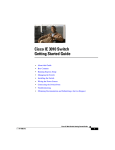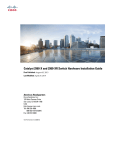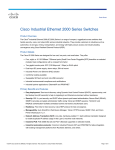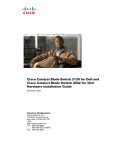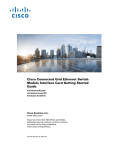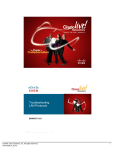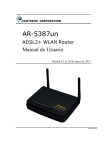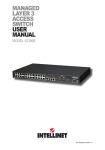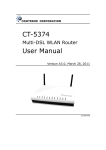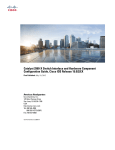Download Cisco Systems IE20004TSL User's Manual
Transcript
Cisco IE 2000 Switch Hardware Installation Guide June 2013 Americas Headquarters Cisco Systems, Inc. 170 West Tasman Drive San Jose, CA 95134-1706 USA http://www.cisco.com Tel: 408 526-4000 800 553-NETS (6387) Fax: 408 527-0883 Text Part Number: OL-25818-04 THE SPECIFICATIONS AND INFORMATION REGARDING THE PRODUCTS IN THIS MANUAL ARE SUBJECT TO CHANGE WITHOUT NOTICE. ALL STATEMENTS, INFORMATION, AND RECOMMENDATIONS IN THIS MANUAL ARE BELIEVED TO BE ACCURATE BUT ARE PRESENTED WITHOUT WARRANTY OF ANY KIND, EXPRESS OR IMPLIED. USERS MUST TAKE FULL RESPONSIBILITY FOR THEIR APPLICATION OF ANY PRODUCTS. THE SOFTWARE LICENSE AND LIMITED WARRANTY FOR THE ACCOMPANYING PRODUCT ARE SET FORTH IN THE INFORMATION PACKET THAT SHIPPED WITH THE PRODUCT AND ARE INCORPORATED HEREIN BY THIS REFERENCE. IF YOU ARE UNABLE TO LOCATE THE SOFTWARE LICENSE OR LIMITED WARRANTY, CONTACT YOUR CISCO REPRESENTATIVE FOR A COPY. The following information is for FCC compliance of Class A devices: This equipment has been tested and found to comply with the limits for a Class A digital device, pursuant to part 15 of the FCC rules. These limits are designed to provide reasonable protection against harmful interference when the equipment is operated in a commercial environment. This equipment generates, uses, and can radiate radio-frequency energy and, if not installed and used in accordance with the instruction manual, may cause harmful interference to radio communications. Operation of this equipment in a residential area is likely to cause harmful interference, in which case users will be required to correct the interference at their own expense. The following information is for FCC compliance of Class B devices: The equipment described in this manual generates and may radiate radio-frequency energy. If it is not installed in accordance with Cisco’s installation instructions, it may cause interference with radio and television reception. This equipment has been tested and found to comply with the limits for a Class B digital device in accordance with the specifications in part 15 of the FCC rules. These specifications are designed to provide reasonable protection against such interference in a residential installation. However, there is no guarantee that interference will not occur in a particular installation. Modifying the equipment without Cisco’s written authorization may result in the equipment no longer complying with FCC requirements for Class A or Class B digital devices. In that event, your right to use the equipment may be limited by FCC regulations, and you may be required to correct any interference to radio or television communications at your own expense. You can determine whether your equipment is causing interference by turning it off. If the interference stops, it was probably caused by the Cisco equipment or one of its peripheral devices. If the equipment causes interference to radio or television reception, try to correct the interference by using one or more of the following measures: • Turn the television or radio antenna until the interference stops. • Move the equipment to one side or the other of the television or radio. • Move the equipment farther away from the television or radio. • Plug the equipment into an outlet that is on a different circuit from the television or radio. (That is, make certain the equipment and the television or radio are on circuits controlled by different circuit breakers or fuses.) Modifications to this product not authorized by Cisco Systems, Inc. could void the FCC approval and negate your authority to operate the product. The Cisco implementation of TCP header compression is an adaptation of a program developed by the University of California, Berkeley (UCB) as part of UCB’s public domain version of the UNIX operating system. All rights reserved. Copyright © 1981, Regents of the University of California. NOTWITHSTANDING ANY OTHER WARRANTY HEREIN, ALL DOCUMENT FILES AND SOFTWARE OF THESE SUPPLIERS ARE PROVIDED “AS IS” WITH ALL FAULTS. CISCO AND THE ABOVE-NAMED SUPPLIERS DISCLAIM ALL WARRANTIES, EXPRESSED OR IMPLIED, INCLUDING, WITHOUT LIMITATION, THOSE OF MERCHANTABILITY, FITNESS FOR A PARTICULAR PURPOSE AND NONINFRINGEMENT OR ARISING FROM A COURSE OF DEALING, USAGE, OR TRADE PRACTICE. IN NO EVENT SHALL CISCO OR ITS SUPPLIERS BE LIABLE FOR ANY INDIRECT, SPECIAL, CONSEQUENTIAL, OR INCIDENTAL DAMAGES, INCLUDING, WITHOUT LIMITATION, LOST PROFITS OR LOSS OR DAMAGE TO DATA ARISING OUT OF THE USE OR INABILITY TO USE THIS MANUAL, EVEN IF CISCO OR ITS SUPPLIERS HAVE BEEN ADVISED OF THE POSSIBILITY OF SUCH DAMAGES. Cisco and the Cisco logo are trademarks or registered trademarks of Cisco and/or its affiliates in the U.S. and other countries. To view a list of Cisco trademarks, go to this URL: www.cisco.com/go/trademarks. Third-party trademarks mentioned are the property of their respective owners. The use of the word partner does not imply a partnership relationship between Cisco and any other company. (1110R) Any Internet Protocol (IP) addresses used in this document are not intended to be actual addresses. Any examples, command display output, and figures included in the document are shown for illustrative purposes only. Any use of actual IP addresses in illustrative content is unintentional and coincidental. Cisco IE 2000 Switch Hardware Installation Guide © 2012, 2013 Cisco Systems, Inc. All rights reserved. CONTENTS Preface vii Audience Purpose vii vii Conventions vii Related Publications viii Obtaining Documentation, Obtaining Support, and Security Guidelines CHAPTER 1 Product Overview 1-1 Switch Models 1-2 viii Front Panel 1-5 10/100BASE-T Downlink Ports 1-8 Power over Ethernet Ports 1-9 10/100BASE-T Uplink Ports 1-9 10/100/1000BASE-T Uplink Ports 1-9 100 Mb/s SFP Module Uplink Slots 1-9 100/1000 Mb/s SFP Module Uplink Slots 1-9 Dual-Purpose Fast Ethernet Uplink Ports 1-9 Dual-Purpose Gigabit Ethernet Uplink Ports 1-10 Power Connectors 1-11 PoE Power Connector 1-12 Alarm Connector 1-12 Management Ports 1-13 LEDs 1-14 Express Setup LED 1-15 System LED 1-15 USB-Mini Console LED 1-15 Alarm LEDs 1-16 Power Status LEDs 1-16 Port Status LEDs 1-17 Dual-Purpose Port LEDs 1-18 PoE Status LED 1-19 Flash Memory Card 1-19 Rear Panel 1-21 Cisco IE 2000 Switch Hardware Installation Guide OL-25818-04 iii Contents Management Options 1-21 Network Configurations CHAPTER 2 Switch Installation 1-22 2-1 Preparing for Installation 2-1 Warnings 2-1 Additional Information for Installation in a Hazardous Environment 2-3 Hazardous Area Installation Warnings 2-3 North American Hazardous Location Approval 2-5 EMC Environmental Conditions for Products Installed in the European Union Installation Guidelines 2-5 Environment and Enclosure Guidelines 2-5 General Guidelines 2-6 Verifying Package Contents 2-7 Installing or Removing the Flash Memory Card (Optional) Connecting to a Console Port 2-9 RJ-45 Console Port 2-10 USB Mini-Type B Console Port 2-5 2-7 2-11 Connecting to Power 2-13 Tools and Equipment 2-13 Supported Power Supplies 2-13 Installing the Power Converter on a DIN Rail, Wall, or Rack Adapter 2-14 Grounding the Switch 2-14 Connecting the Power Converter to an AC Power Source 2-17 Preparing the AC Power Connection 2-17 Connecting the AC Power Source to the Power Converter 2-18 Connecting the Power Converter to a DC Power Source 2-19 Wiring the DC Power Source 2-20 Attaching the Power Connectors to the Switch 2-25 Connecting Power to the Switch PoE DC-Input (Optional) 2-28 Applying Power to the Power Converter 2-30 Running Boot Fast 2-30 Powering On the Switch 2-30 Verifying Boot Fast 2-31 Disconnecting Power 2-31 Installing the Switch 2-31 Installing the Switch on a DIN Rail 2-32 Removing the Switch from a DIN Rail 2-33 Connecting Alarm Circuits 2-34 Cisco IE 2000 Switch Hardware Installation Guide iv OL-25818-04 Contents Wiring the Protective Ground and DC Power for Alarm Circuits Wiring the External Alarms 2-35 Attaching the Alarm Connector to the Switch 2-38 2-34 Connecting Destination Ports 2-39 Connecting to 10/100 and 10/100/1000 Ports 2-40 Installing and Removing SFP Modules 2-42 Installing SFP Modules into SFP Module Slots 2-42 Removing SFP Modules from SFP Module Slots 2-43 Connecting to SFP Modules 2-44 Connecting to a Dual-Purpose Port 2-46 Verifying Switch Operation Where to Go Next CHAPTER 3 Troubleshooting 2-47 2-47 3-1 Diagnosing Problems 3-1 Switch Boot Fast 3-1 Switch LEDs 3-2 Switch Connections 3-2 Bad or Damaged Cable 3-2 Ethernet and Fiber-Optic Cables 3-2 Link Status 3-2 10/100 and 10/100/1000 Port Connections 3-3 SFP Module 3-3 Interface Settings 3-3 Ping End Device 3-3 Spanning Tree Loops 3-3 Switch Performance 3-4 Speed, Duplex, and Autonegotiation 3-4 Autonegotiation and Network Interface Cards 3-4 Cabling Distance 3-4 Resetting the Switch 3-5 How to Recover Passwords 3-5 Finding the Switch Serial Number APPENDIX A Technical Specifications 3-6 A-1 Operating Temperature Specifications Technical Specifications Alarm Ratings A-1 A-2 A-6 Cisco IE 2000 Switch Hardware Installation Guide OL-25818-04 v Contents Hazardous Locations Standards APPENDIX B Cable and Connectors A-6 B-1 Connector Specifications B-1 10/100 Ports B-1 SFP Module Connectors B-2 Dual-Purpose Ports B-2 Console Port B-2 Alarm Port B-3 Cables and Adapters B-4 SFP Module Cables B-4 Cable Pinouts B-7 Console Port Adapter Pinouts APPENDIX C B-8 Configuring the Switch with the CLI-Based Setup Program C-1 Accessing the CLI Through the Console Port C-1 Removing the USB Mini-Type B Console Port Cover C-1 RJ-45 Console Port C-2 USB Mini-Type B Console Port C-4 Installing the Cisco Microsoft Windows USB Device Driver C-5 Installing the Cisco Microsoft Windows XP USB Driver C-5 Installing the Cisco Microsoft Windows 2000 USB Driver C-6 Installing the Cisco Microsoft Windows Vista and Windows 7 USB Driver C-6 Uninstalling the Cisco Microsoft Windows USB Driver C-7 Uninstalling the Cisco Microsoft Windows XP and 2000 USB Driver C-7 Uninstalling the Cisco Microsoft Windows Vista and Windows 7 USB Driver C-7 Entering the Initial Configuration Information IP Settings C-8 Completing the Setup Program C-8 C-8 Cisco IE 2000 Switch Hardware Installation Guide vi OL-25818-04 Preface Audience This guide is for the networking or computer technician responsible for installing Cisco IE 2000 series switches. We assume that you are familiar with the concepts and terminology of Ethernet and local area networking. Purpose This guide documents the hardware features of the Cisco IE 2000 switches. It describes the physical and performance characteristics of each switch, explains how to install a switch, and provides troubleshooting information. This guide does not describe system messages that you might receive or how to configure your switch. For more information, see the Cisco IE2000 documentation at http://www.cisco.com/en/US/products/ps12451/tsd_products_support_series_home.html For information about the standard Cisco IOS commands, see http://www.cisco.com/cisco/web/psa/configure.html?mode=prod&level0=268438303 Conventions This document uses the following conventions and symbols for notes, cautions, and warnings. Note Caution Means reader take note. Notes contain helpful suggestions or references to materials not contained in this manual. Means reader be careful. In this situation, you might do something that could result in equipment damage or loss of data. Cisco IE 2000 Switch Hardware Installation Guide OL-25818-04 vii Chapter Warning This warning symbol means danger. You are in a situation that could cause bodily injury. Before you work on any equipment, be aware of the hazards involved with electrical circuitry and be familiar with standard practices for preventing accidents. Use the statement number provided at the end of each warning to locate its translation in the translated safety warnings that accompanied this device. Statement 1071 The safety warnings for this product are translated into several languages in the Regulatory Compliance and Safety Information for the Cisco IE 2000 Switch that ships with the product. The EMC regulatory statements are also included in that guide. Related Publications Before installing, configuring, or upgrading the switch, see the release notes on Cisco.com for the latest information. These documents provide complete information about the switch and are available on Cisco.com: • Cisco IE 2000 Switch Getting Started Guide • Regulatory Compliance and Safety Information for the Cisco IE 2000 Switch • Release Notes for the Cisco IE 2000 Switch • Cisco IE 2000 Switch Software Configuration Guide • Cisco IE 2000 Switch Command Reference • Cisco IE 2000 Switch System Message Guide • Device Manager online help (available on the switch) • Cisco Small Form-Factor Pluggable Modules Installation Notes These compatibility matrix documents are available from this Cisco.com site: http://www.cisco.com/en/US/products/hw/modules/ps5455/products_device_support_tables_list.html • Cisco Gigabit Ethernet Transceiver Modules Compatibility Matrix (not orderable but available on Cisco.com) • Cisco Small Form-Factor Pluggable Modules Compatibility Matrix (not orderable but available on Cisco.com) Obtaining Documentation, Obtaining Support, and Security Guidelines For information on obtaining documentation, obtaining support, providing documentation feedback, security guidelines, and also recommended aliases and general Cisco documents, see the monthly What’s New in Cisco Product Documentation, which also lists all new and revised Cisco technical documentation, at: http://www.cisco.com/en/US/docs/general/whatsnew/whatsnew.html Cisco IE 2000 Switch Hardware Installation Guide viii OL-25818-04 CH A P T E R 1 Product Overview This switch provides a rugged and secure switching infrastructure for harsh environments. It is suitable for industrial Ethernet applications, including factory automation, intelligent transportation systems (ITSs), substations, oil and gas installations, and other deployments in harsh environments. You can connect this switch to office networking devices such as Cisco IP phones, Cisco Wireless Access Points workstations, and other devices such as servers, routers, and other switches. In industrial environments, you can connect any Ethernet-enabled industrial communication devices, including programmable logic controllers (PLCs), human-machine interfaces (HMIs), drives, sensors, video devices, traffic signal controllers, and intelligent electronic devices (IEDs). You can mount the switch on a DIN rail in an industrial enclosure. Its components are designed to withstand extremes in temperature, vibration, and shock that are common in an industrial environment. The chapter includes the following topics: • Switch Models, page 1-2 • Front Panel, page 1-5 • Rear Panel, page 1-21 • Management Options, page 1-21 • Network Configurations, page 1-22 Cisco IE 2000 Switch Hardware Installation Guide OL-25818-04 1-1 Chapter 1 Product Overview Switch Models Switch Models Table 1-1 lists and describes the switch models. Table 1-1 Switch Descriptions Model Description Software Image Cisco IE-2000-4T-L 4 10/100BASE-T downlink ports 2 10/100BASE-T uplink ports LAN Lite Cisco IE-2000-4T-B 4 10/100BASE-T downlink ports 2 10/100BASE-T uplink ports LAN Base Cisco IE-2000-4T-G-L 4 10/100BASE-T downlink ports 2 10/100/1000BASE-T uplink ports LAN Lite Cisco IE-2000-4T-G-B 4 10/100BASE-T downlink ports 2 10/100/1000BASE-T uplink ports LAN Base Cisco IE-2000-4TS-L 4 10/100BASE-T downlink ports 2 100 Mb/s SFP (small form-factor pluggable) module uplink slots LAN Lite Cisco IE-2000-4TS-B 4 10/100BASE-T Ethernet ports 2 100 Mb/s SFP module uplink slots LAN Base Cisco IE-2000-4TS-G-L 4 10/100BASE-T downlink ports 2 100/1000 Mb/s SFP module uplink slots LAN Lite Cisco IE-2000-4TS-G-B 4 10/100BASE-T downlink ports 2 100/1000 Mb/s SFP module uplink slots LAN Base Cisco IE-2000-8TC-L 8 10/100BASE-T downlink ports 2 Fast Ethernet dual-purpose uplink ports LAN Lite Cisco IE-2000-8TC-B 8 10/100BASE-T downlink ports 2 Fast Ethernet dual-purpose uplink ports LAN Base Cisco IE-2000-8TC-G-L 8 10/100BASE-T downlink ports 2 Gigabit Ethernet dual-purpose uplink ports LAN Lite Cisco IE-2000-8TC-G-B 8 10/100BASE-T downlink ports 2 Gigabit Ethernet dual-purpose uplink ports LAN Base Cisco IE-2000-8TC-G-E 8 10/100BASE-T downlink ports 2 Gigabit Ethernet dual-purpose uplink ports LAN Base with 1588 Supports the IEEE-1588 standard for synchronizing clocks. Can enable NAT by license upgrade. Cisco IE-2000-8TC-G-N 8 10/100BASE-T downlink ports 2 Gigabit Ethernet dual-purpose uplink ports LAN Base with 1588 and NAT Supports the IEEE-1588 standard for synchronizing clocks and Network Address Translation (NAT) Cisco IE 2000 Switch Hardware Installation Guide 1-2 OL-25818-04 Chapter 1 Product Overview Switch Models Table 1-1 Switch Descriptions (continued) Model Description Software Image Cisco IE-2000-16TC-L 16 10/100BASE-T downlink ports, LAN Lite 2 Fast Ethernet dual-purpose uplink ports 2 100 Mb/s SFP module uplink slots Cisco IE-2000-16TC-B 16 10/100BASE-T downlink ports LAN Base 2 Fast Ethernet dual-purpose uplink ports 2 100 Mb/s SFP module uplink slots Cisco IE-2000-16TC-G-L 16 10/100BASE-T downlink ports LAN Lite 2 Gigabit Ethernet dual-purpose uplink ports 2 100 Mb/s SFP module uplink slots Cisco IE-2000-16TC-G-E 16 10/100BASE-T downlink ports 2 Gigabit Ethernet dual-purpose uplink ports LAN Base with 1588 2 100 Mb/s SFP module uplink slots Supports the IEEE-1588 standard for synchronizing clocks. Can enable NAT by license upgrade. Cisco IE-2000-16TC-G-N 16 10/100BASE-T downlink ports 2 Gigabit Ethernet dual-purpose uplink ports LAN Base with 1588 and NAT Supports the IEEE-1588 standard for synchronizing clocks and Network Address Translation (NAT). Cisco IE-2000-16TC-G-X 16 10/100BASE-T downlink ports 2 Gigabit Ethernet uplink ports, and 2 100 Mb/s SFP module uplink slots LAN Base with 1588 and conformal coat Supports the IEEE-1588 standard for synchronizing clocks. Can enable NAT by license upgrade. Cisco IE-2000-16PTC-G-E 12 10/100BASE-T downlink ports 2 Gigabit Ethernet dual-purpose uplink ports LAN Base with 1588 4 Power over Ethernet (PoE) ports Note The four PoE ports can operate as PoE or as PoE+ if sufficient external power source is provided. Supports the IEEE-1588 standard for synchronizing clocks. Can enable NAT by license upgrade. Cisco IE 2000 Switch Hardware Installation Guide OL-25818-04 1-3 Chapter 1 Product Overview Switch Models Table 1-1 Switch Descriptions (continued) Model Description Software Image Cisco IE-2000-16PTC-G-L 12 10/100BASE-T downlink ports LAN Lite 2 Gigabit Ethernet dual-purpose uplink ports 4 Power over Ethernet (PoE) ports Note Cisco IE-2000-16PTC-G-NX The four PoE ports can operate as PoE or as PoE+ if sufficient external power source is provided. 12 10/100BASE-T downlink ports 2 Gigabit Ethernet dual-purpose uplink ports LAN Base with 1588 and conformal coat 4 Power over Ethernet (PoE) ports Note The four PoE ports can operate as PoE or as PoE+ if sufficient external power source is provided. Note Supports the IEEE-1588 standard for synchronizing clocks and Network Address Translation (NAT). Cisco IE 2000 Switch Hardware Installation Guide 1-4 OL-25818-04 Chapter 1 Product Overview Front Panel Front Panel This section describes the front panel components. See Table 1-1. • 10/100BASE-T Ethernet ports • 10/100/1000 uplink ports (available on some models). • Dual-purpose ports (available on some models). • SFP module slots (available on some models). • PoE/PoE+ ports (available on some models). See Power over Ethernet Ports, page 1-9. • RJ-45 console port • USB mini-Type B (console) port • LEDs • Power connectors • Alarm connector • Flash memory card slot The following figures depict the components available on the various models in this product family. Not all models are illustrated. Figure 1-1 Cisco IE-2000-4TS-L Front Panel View 3 4 1 5 ±12/ 0.5- 24/48 2.0A 6 2 7 4TS 331547 8 9 1 10/100 Ethernet ports (downlink ports) 6 2 SFP module slots (uplink ports) 7 Power connector DC-B Alarm connector Cisco IE 2000 Switch Hardware Installation Guide OL-25818-04 1-5 Chapter 1 Product Overview Front Panel 3 USB mini-Type B (console) port 8 Protective ground connection 4 RJ-45 console port 9 Flash memory card slot 5 Power connector DC-A Figure 1-2 Cisco IE-2000-8TC-L Front Panel 331545 3 1 4 5 ±12/ 24 0.5- /48 2.0A 6 2 7 8TC 8 9 1 10/100 Ethernet ports (downlink ports) 6 Power connector DC-B 2 Dual-purpose ports (uplink ports) 7 Alarm connector 3 USB mini-Type B (console) port 8 Protective ground connection 4 RJ-45 console port 9 Flash memory card slot 5 Power connector DC-A Cisco IE 2000 Switch Hardware Installation Guide 1-6 OL-25818-04 Chapter 1 Product Overview Front Panel Cisco IE-2000-16TC-L Front Panel View 331544 Figure 1-3 3 1 4 5 ±12/ 24 0.5-3 /48 .0A 6 10 16T C 7 8 2 9 1 10/100 Ethernet ports (downlink ports) 6 Power connector DC-B 2 Dual-purpose ports (uplink ports) 7 Alarm connector 3 USB mini-Type B (console) port 8 Protective ground connection 4 RJ-45 console port 9 Flash memory card slot 5 Power connector DC-A 10 SFP module slots Cisco IE 2000 Switch Hardware Installation Guide OL-25818-04 1-7 Chapter 1 Product Overview Front Panel Figure 1-4 Cisco IE-2000-16PTC-G-E Switch Front Panel View 3 1 4 5 ±12/ 0.5- 24/48 3.0A PoE STA TUS 10 6 PoE DC IN DC IN + 16P TCG 7 54V Inpu , 12A t DC 8 347587 2 9 1 10/100 Ethernet ports (downlink ports) 6 Power connector DC-B 2 Dual-purpose ports (uplink ports) 7 Alarm connector 3 USB mini-Type B (console) port 8 Protective ground connection 4 RJ-45 console port 9 Flash memory card slot 5 Power connector DC-A 10 PoE power connector 10/100BASE-T Downlink Ports You can set the 10/100BASE-T downlink ports to operate at 10 or 100 Mb/s in full-duplex or half-duplex mode. You can also set these ports for speed and duplex autonegotiation in compliance with IEEE 802.3AB. (The default setting is autonegotiate.) When set for autonegotiation, the port senses the speed and duplex settings of the attached device and advertises its own capabilities. If the connected device also supports autonegotiation, the switch port negotiates the best connection (that is, the fastest line speed that both devices support, and full-duplex transmission if the attached device supports it) and configures itself accordingly. In all cases, the attached device must be within 328 feet (100 meters). 100BASE-TX traffic requires Category 5 cable. 10BASE-T traffic can use Category 3 or Category 4 cables. When connecting the switch to workstations, servers, routers, and Cisco IP phones, make sure that the cable is a straight-through cable. Cisco IE 2000 Switch Hardware Installation Guide 1-8 OL-25818-04 Chapter 1 Product Overview Front Panel You can use the mdix auto interface configuration command in the command-line interface (CLI) to enable the automatic medium-dependent interface crossover (auto-MDIX) feature. When the autoMDIX feature is enabled, the switch detects the required cable type for copper Ethernet connections and configures the interfaces accordingly. For configuration information for this feature, see the switch software configuration guide or the switch command reference. Power over Ethernet Ports On certain models of the IE 2000 switch, four of the 10/100BASE-T ports are available as PoE ports. The four ports can operate as PoE (IEEE 802.3af) ports or can be configured to operate as PoE+ (IE 802.at) ports. Each PoE port requires 15.4 Watts of power while PoE+ requires 30 Watts. A 54VDC /1.2Amp power source (65W) can support 4 PoE ports or 2 PoE+ ports. Cable lengths of up to 328 ft (100 m) are supported. 10/100BASE-T Uplink Ports The IEEE 802.3u 10/100BASE-T uplink ports provide full-duplex 10, 100 Mb/s connectivity over Category 5 unshielded twisted pair (UTP) copper cabling. The default setting is autonegotiate. The cable can be up to 100 m (0.1 km) in length. 10/100/1000BASE-T Uplink Ports The IEEE 802.3u 10/100/1000BASE-T uplink ports provide full-duplex 10, 100 or 1000 Mb/s connectivity over Category 5 unshielded twisted pair (UTP) copper cabling. The default setting is autonegotiate. The cable can be up to 100 m (0.1 km) in length. 100 Mb/s SFP Module Uplink Slots The IEEE 802.3u 100 Mb/s SFP module uplink slots provide full-duplex 100 Mb/s connectivity over multi-mode (MM) fiber cables or single-mode (SM) fiber cables. These ports use a SFP fiber-optic transceiver module that accepts a dual LC connector. Check the SFP specifications for the cable type and length. 100/1000 Mb/s SFP Module Uplink Slots The IEEE 802.3u 100 Mb/s SFP module uplink slots provide full-duplex 100 or 1000 Mb/s connectivity over multi-mode (MM) fiber cables or single-mode (SM) fiber cables. These ports use a SFP fiber-optic transceiver module that accepts a dual LC connector. Check the SFP specifications for the cable type and length. Dual-Purpose Fast Ethernet Uplink Ports You can configure the dual-purpose Fast Ethernet uplink ports on the switch as either 10/100BASE-T ports or as 100 Mb/s SFP-module ports. You can set the 10/100 ports to autonegotiate, or you can configure them as fixed 10 or 100 Mb/s ports. Cisco IE 2000 Switch Hardware Installation Guide OL-25818-04 1-9 Chapter 1 Product Overview Front Panel By default, the switch selects the medium for each dual-purpose port (10/100BASE-T or SFP). When a link is achieved on one media type, the switch disables the other media type until the active link goes down. If links are active on both media, the SFP-module port has priority, but you can use the mediatype interface configuration command to manually designate the port as an RJ-45 port or an SFP port. You can configure the speed and duplex settings consistent with the selected media type. For information on configuring interfaces, see the switch software configuration guide. Dual-Purpose Gigabit Ethernet Uplink Ports You can configure the dual-purpose Gigabit Ethernet uplink ports on the switch as either 10/1001000BASE-T ports or as 100/1000 Mb/s SFP-module ports. You can set the 10/100/1000BASET ports to autonegotiate, or you can configure them as fixed 10, 100, or 1000 Mb/s (Gigabit) Ethernet ports. By default, the switch selects the medium for each dual-purpose port (10/100/1000BASE-T or SFP). When a link is achieved on one media type, the switch disables the other media type until the active link goes down. If links are active on both media, the SFP-module port has priority, but you can use the media-type interface configuration command to manually designate the port as an RJ-45 port or an SFP port. You can configure the speed and duplex settings consistent with the selected media type. For information on configuring interfaces, see the switch software configuration guide. SFP Modules The SFP modules are switch Ethernet SFP modules that provide connections to other devices. These field-replaceable transceiver modules provide the uplink interfaces. The modules have LC connectors for fiber-optic connections. Note The Cisco IE 2000 switch does not support copper SFP modules. You can use any combination of the supported SFP modules: Table 1-2 Supported SFP Models Type of SFP Module Rugged and Industrial SFPs Model • GLC-SX-MM-RGD with digital optical monitoring (DOM) support • GLC-LX-SM-RGD with DOM support • GLC-ZX-SM-RGD with DOM support –40 to 185°F (–40 to 85°C) Cisco IE 2000 Switch Hardware Installation Guide 1-10 OL-25818-04 Chapter 1 Product Overview Front Panel Table 1-2 Supported SFP Models Type of SFP Module Model Commercial SFPs • GLC-SX-MM 32 to 158°F (0 to 70°C) • GLC-LH-SM • GLC-BX-U with DOM support • GLC-BX-D with DOM support • CWDM-SFP with DOM support • DWDM-SFP with DOM support Extended temperature SFPs • SFP-GE-S with DOM support 23 to 185°F (–5 to 85°C) • SFP-GE-L with DOM support • SFP-GE-Z with DOM support • GLC-SX-SMD • GLC-LH-SMD • GLC-EX-SMD For the most up-to-date list of supported SFP models for Cisco Industrial Ethernet switches, see http://www.cisco.com/en/US/docs/interfaces_modules/transceiver_modules/compatibility/matrix/OL_ 6981.html#wp138176 For installation instructions, see your SFP module documentation and the “Installing and Removing SFP Modules” section on page 2-42. For cable specifications, see the “SFP Module Cables” section on page B-4. Power Connectors You connect the DC power to the switch through the front panel connectors. The switch has a dual-feed DC power supply; two connectors provide primary and secondary DC power (DC-A and DC-B). The DC power connectors are near the top right of the front panel. See Figure 1-1. Each power connector has an LED status indicator. The switch power connectors are attached to the switch chassis. Each power connector has screw terminals for terminating the DC power (see Figure 1-5). All connectors are attached to the switch front panel with the provided captive screws. The power connector labeling is on the panel. The positive DC power connection is labeled “+”, and the return connection is labeled “–”. Cisco IE 2000 Switch Hardware Installation Guide OL-25818-04 1-11 Chapter 1 Product Overview Front Panel Power Connector 331209 Figure 1-5 The switch can operate with a single power source or with dual power sources. When both power sources are operational, the switch draws power from the DC source with the higher voltage. If one of the two power sources fail, the other continues to power the switch. PoE Power Connector The IE 2000 switch models with PoE capability (IE-2000-16PTC-G-E, IE-2000-16PTC-G-L, and IE2000-16PTC-G-NX) are equipped with an additional DC input terminal block. This DC terminal block allows the connection of a second power supply (see the “Power over Ethernet Ports” section on page 19), or a second input from site source DC power to operate the PoE ports. The PoE terminal block accepts 48 VDC or 54 VDC at 2.5 A. Alarm Connector You connect the alarm signals to the switch through the alarm connector. The switch supports two alarm inputs and one alarm output relay. The alarm connector is on the bottom right of the front panel. See Figure 1-2. The alarm connector provides six alarm wire connections. The connector is attached to the switch front panel with the provided captive screws. Alarm Connector 331208 Figure 1-6 Both alarm input circuits can sense if the alarm input is open or closed. The alarm inputs can be activated for environmental, power supply, and port status alarm conditions. From the CLI, you can configure each alarm input as an open or closed contact. The alarm output circuit is a relay with a normally open and a normally closed contact. The switch is configured to detect faults that are used to energize the relay coil and change the state on both of the relay contacts: normally open contacts close, and normally closed contacts open. The alarm output relay can be used to control an external alarm device, such as a bell or a light. See the switch software configuration guide for instructions on configuring the alarm relays. For more information about the alarm connector, see Appendix B, “Cable and Connectors.” Cisco IE 2000 Switch Hardware Installation Guide 1-12 OL-25818-04 Chapter 1 Product Overview Front Panel Management Ports You can connect the switch to a PC running Microsoft Windows or to a terminal server through either the RJ-45 console port or the USB mini-Type B console port, also referred to as the USB-mini console port. These ports use the following connectors: • RJ-45 console port uses an RJ-45-to-DB-9 female cable. • USB-mini console port (5-pin connector) uses a USB Type A-to-5-pin mini-Type B cable. The USB-mini console interface speeds are the same as the RJ-45 console interface speeds. To use the USB-mini console port, you must install the Cisco Windows USB device driver on the device that is connected to the USB-mini console port and that is running Microsoft Windows. Note For information about downloading the Cisco USB device driver, see the “Installing the Cisco Microsoft Windows USB Device Driver” section on page C-5. With the Cisco Windows USB device driver, connecting and disconnecting the USB cable from the console port does not affect Windows HyperTerminal operations. Mac OS X or Linux require no special drivers. Note The 5-pin mini-Type B connectors resemble the 4-pin mini-Type B connectors, but they are not compatible. Use only the 5-pin mini-Type B. See Figure 1-7. USB Mini-Type B Port 253163 Figure 1-7 The configurable inactivity timeout reactivates the RJ-45 console port if the USB-mini console port is activated, but no input activity occurs for a specified time period. When the USB-mini console port deactivates due to a timeout, you can restore its operation by disconnecting and reconnecting the USB cable. For information on using the CLI to configure the USB-mini console interface, see the switch software guide. Cisco IE 2000 Switch Hardware Installation Guide OL-25818-04 1-13 Chapter 1 Product Overview Front Panel LEDs You can use the LEDs to monitor the switch status, activity, and performance. Figure 1-8 and Figure 19 show the front panel LEDs. Figure 1-8 LEDs on the Cisco IE 2000 Switch 2 3 4 5 7 ±12 /2 0.5- 4/48 3.0A ±12/ 24 0.5-3 /48 .0A 1 16T C 6 9 Note 1 Alarm LEDs 6 2 USB mini-Type B (console) port LED 7 3 Express Setup LED 8 SFP module slot LEDs 4 System LED 9 Dual-purpose uplink port LEDs 5 Power connector DC-A LED 331565 8 Power connector DC-B LED 10/100BASE-T downlink port LEDs On IE 2000 switches with PoE support, the two SFP ports and the associated LEDs are replaced by a PoE DC-input terminal block and a PoE LED. See Table 1-10 for the PoE LED colors and meanings. Cisco IE 2000 Switch Hardware Installation Guide 1-14 OL-25818-04 Chapter 1 Product Overview Front Panel Express Setup LED The Express Setup LED displays the express setup mode for the initial configuration. Table 1-3 lists the LED colors and their meanings. Table 1-3 Setup LED Color Setup Status Off (dark) Switch is configured as a managed switch. Solid green Switch is operating normally. Blinking green Switch is in initial setup, in recovery, or initial setup is incomplete. Solid red Switch failed to start initial setup or recovery because there is no available switch port to which to connect the management station. Disconnect a device from a switch port, and then press the Express Setup button. System LED The System LED shows whether the system is receiving power and is functioning properly. Table 1-4 lists the system LED colors and their meanings. Table 1-4 System LED Color System Status Off System is not powered on. Blinking green Boot fast is in progress. Green System is operating normally. Red Switch is not functioning properly. USB-Mini Console LED The USB-mini console LED shows which console port is in use. See Figure 1-8 for the LED location. If you connect a cable to a console port, the switch automatically uses that port for console communication. If you connect two console cables, the USB-mini console port has priority. Table 1-5 describes the system LED colors and their meanings. Table 1-5 USB-Mini Console Port LED Color Description Green USB-mini console port is active. RJ-45 console port LED is not active. Off Port is not active. RJ-45 console port is active. Cisco IE 2000 Switch Hardware Installation Guide OL-25818-04 1-15 Chapter 1 Product Overview Front Panel Alarm LEDs Table 1-6 and Table 1-7 list the alarm LED colors and their meanings. Table 1-6 Alarm OUT Status LED Color System Status Off Alarm OUT is not configured, or the switch is off. Green Alarm OUT is configured, no alarm detected. Blinking red Switch has detected a major alarm. Red Switch has detected a minor alarm. Table 1-7 Alarm IN1 and IN2 Status LEDs Color System Status Off Alarm IN1 or IN2 not configured. Green Alarm IN1 or IN2 configured, no alarm detected. Blinking red Major alarm detected. Red Minor alarm detected. Power Status LEDs The switch can operate with one or two DC power sources. Each DC input has an associated LED that shows the status of the corresponding DC input. If power is present on the circuit, the LED is green. If power is not present, the LED color depends on the alarm configuration. If alarms are configured, the LED is red when power is not present; otherwise, the LED is off. If the switch has dual power sources, the switch draws power from the power source with the higher voltage. If one of the DC sources fails, the alternate DC source powers the switch, and the corresponding power status LED is green. The power status for the failed DC source is either off or red, depending on the alarm configuration. Table 1-8 lists the power status LED colors and meanings. Table 1-8 Note Power Status LEDs Color System Status Green Power is present on the associated circuit, system is operating normally. Off Power is not present on the circuit, or the system is not powered up. Red Power is not present on the associated circuit, and the power supply alarm is configured. The Power A and Power B LEDs show that power is not present on the switch if the power input drops below the low valid level. The power status LEDs only show that power is present if the voltage at the switch input exceeds the valid level. For information about the power LED colors during the boot fast sequence, see the “Verifying Switch Operation” section on page 2-47. Cisco IE 2000 Switch Hardware Installation Guide 1-16 OL-25818-04 Chapter 1 Product Overview Front Panel Port Status LEDs Each 10/100BASE-T downlink port, 10/100BASE-T uplink port, 10/100/1000BASE-T uplink port, dual-purpose uplink port, and SFP Module uplink slot has a port status LED, also called a port LED, as shown in Figure 1-8 and Figure 1-9. Table 1-9 displays LED information about the switch and the individual ports. Table 1-9 Port Status LEDs Color System Status Off No link. Solid green Link present. Blinking green Activity. Port is sending or receiving data. Alternating green-amber Link fault. Error frames can affect connectivity, and errors such as excessive collisions, CRC errors, and alignment and jabber errors are monitored for a link-fault indication. Solid amber Port is not forwarding. The port was disabled by management, an address violation, or STP. Note After a port is reconfigured, the port LED can remain amber for up to 30 seconds while STP checks the switch for possible loops. Cisco IE 2000 Switch Hardware Installation Guide OL-25818-04 1-17 Chapter 1 Product Overview Front Panel Dual-Purpose Port LEDs Figure 1-9 shows the LEDs on a dual-purpose port. You can configure each port as either a 10/100/1000BASE-T port through the RJ-45 connector or as an SFP module, but not both at the same time. The LEDs show how the port is being used (Ethernet or SFP module). The LED colors have the same meanings as described in Table 1-9. Dual-Purpose Port LEDs 332704 Figure 1-9 ±12/ 24 0.5-3 /48 .0A 16T C 1 1 Dual-purpose port LEDs Cisco IE 2000 Switch Hardware Installation Guide 1-18 OL-25818-04 Chapter 1 Product Overview Front Panel PoE Status LED The PoE STATUS LED is located on the front panel of the IE 2000 switch models that are equipped with PoE ports.The LED displays the functionality and status of the PoE ports. The LED colors and meanings are listed in Table 1-10. Table 1-10 PoE Status LED Colors and Meanings Color PoE Status Off PoE is off. If the powered device is receiving power from a non-PoE power source, the port LED is off even if the powered device is connected to the switch port. Green PoE is on. The port LED is green only when the PoE port is providing power. Alternating green and amber PoE is denied because providing power to the powered device will exceed the switch power capacity. Flashing amber PoE is off due to a fault. Caution Amber Noncompliant cabling or powered devices can cause a PoE port fault. Use only standard-compliant cabling to connect Cisco prestandard IP Phones and wireless access points or IEEE 802.3af-compliant devices. You must remove any cable or device that causes a PoE fault. PoE for the port is disabled. (PoE is enabled by default.) Flash Memory Card The switch supports a flash memory card that makes it possible to replace a failed switch without reconfiguring the new switch. The slot for the flash memory card is on the front of the switch. See Figure 1-10. The flash card is hot swappable and can be accessed on the front panel. A cover protects the flash card and holds the card firmly in place. The cover is hinged and closed with a captive screw. This prevents the card from coming loose and protects against shock and vibration. Note For more information on inserting and removing the flash memory card, see the “Installing or Removing the Flash Memory Card (Optional)” section on page 2-7. Cisco IE 2000 Switch Hardware Installation Guide OL-25818-04 1-19 Chapter 1 Product Overview Front Panel Figure 1-10 Flash Memory Card Slot 331548 ±12/ 24 0.5-3 /48 .0A 16T C Note The replacement SD card part number is SD-IE-1GB. Cisco IE 2000 Switch Hardware Installation Guide 1-20 OL-25818-04 Chapter 1 Product Overview Rear Panel Rear Panel The rear panel of the switch has a latch for installation on a DIN rail. See Figure 1-11. The latch is spring-loaded to move down to position the switch over a DIN rail and return to the original position to secure the switch to a DIN rail. Figure 1-11 Cisco IE 2000 Switch Rear Panel 331552 1 1 Latch Management Options The switch supports these management options: • Cisco Network Assistant Cisco Network Assistant is a PC-based network management GUI application optimized for LANs of small- and medium-sized businesses. Using the GUI, you can configure and manage switch clusters or standalone switches. Cisco Network Assistant is available at no cost and can be downloaded from this URL: http://www.cisco.com/en/US/products/ps5931/tsd_products_support_series_home.html For information on starting the Cisco Network Assistant application, see the Getting Started with Cisco Network Assistant guide on Cisco.com. • Device Manager You can use Device Manager, which is in the switch memory, to manage individual and standalone switches. This web interface offers quick configuration and monitoring. You can access Device Manager from anywhere in your network through a web browser. For more information, see the getting started guide and the Device Manager online help. Cisco IE 2000 Switch Hardware Installation Guide OL-25818-04 1-21 Chapter 1 Product Overview Network Configurations • Cisco IOS CLI The switch CLI is based on Cisco IOS software and is enhanced to support desktop-switching features. You can fully configure and monitor the switch. You can access the CLI either by connecting your management station directly to the switch management port, or a console port, or by using Telnet from a remote management station. See the switch command reference on Cisco.com for more information. • Cisco Prime LAN Management Solution 4.2 http://www.cisco.com/en/US/docs/net_mgmt/ciscoworks_lan_management_solution/4.2/device_su pport/table/lms42sdt.html#Cisco IE 2000 Series Switches • SNMP network management You can manage switches from a SNMP-compatible management station that is running platforms such as HP OpenView or SunNet Manager. The switch supports a comprehensive set of Management Information Base (MIB) extensions and four Remote Monitoring (RMON) groups. See the switch software configuration guide on Cisco.com and the documentation that came with your SNMP application for more information. • Common Industrial Protocol The Common Industrial Protocol (CIP) management objects are supported. The Cisco IE 2000 can be managed by CIP-based management tools, allowing the user to manage an entire industrial automation system with one tool. • PROFINET TCP/IP and RT This switch supports PROFINET TCP/IP and RT and can be managed by Siemens' automation software such as STEP 7. Network Configurations See the switch software configuration guide on Cisco.com for network configuration concepts and examples of using the switch to create dedicated network segments and interconnecting the segments through Gigabit Ethernet connections. Cisco IE 2000 Switch Hardware Installation Guide 1-22 OL-25818-04 CH A P T E R 2 Switch Installation This chapter describes how to install your switch, verify the boot fast, and connect the switch to other devices. It also includes information specifically for installations in hazardous environments. Read these topics, and perform the procedures in this order: • Preparing for Installation, page 2-1 • Installing or Removing the Flash Memory Card (Optional), page 2-7 • Connecting to a Console Port, page 2-9 • Connecting to Power, page 2-13 • Installing the Switch, page 2-31 • Connecting Alarm Circuits, page 2-34 • Connecting Destination Ports, page 2-39 • Verifying Switch Operation, page 2-47 • Where to Go Next, page 2-47 Preparing for Installation This section provides information about these topics: • Warnings, page 2-1 • Additional Information for Installation in a Hazardous Environment, page 2-3 • Installation Guidelines, page 2-5 • Verifying Package Contents, page 2-7 Warnings These warnings are translated into several languages in the Regulatory Compliance and Safety Information for this switch. Warning Before working on equipment that is connected to power lines, remove jewelry (including rings, necklaces, and watches). Metal objects will heat up when connected to power and ground and can cause serious burns or weld the metal object to the terminals. Statement 43 Cisco IE 2000 Switch Hardware Installation Guide OL-25818-04 2-1 Chapter 2 Switch Installation Preparing for Installation Warning Do not work on the system or connect or disconnect cables during periods of lightning activity. Statement 1001 Warning Before performing any of the following procedures, ensure that power is removed from the DC circuit. Statement 1003 Warning Read the installation instructions before you connect the system to its power source. Statement 1004 Warning This unit is intended for installation in restricted access areas. A restricted access area can be accessed only through the use of a special tool, lock and key, or other means of security. Statement 1017 Warning This equipment must be grounded. Never defeat the ground conductor or operate the equipment in the absence of a suitably installed ground conductor. Contact the appropriate electrical inspection authority or an electrician if you are uncertain that suitable grounding is available. Statement 1024 Warning This unit might have more than one power supply connection. All connections must be removed to de-energize the unit. Statement 1028 Warning Only trained and qualified personnel should be allowed to install, replace, or service this equipment. Statement 1030 Warning Ultimate disposal of this product should be handled according to all national laws and regulations. Statement 1040 Warning For connections outside the building where the equipment is installed, the following ports must be connected through an approved network termination unit with integral circuit protection. 10/100/1000 Ethernet Statement 1044 Warning To prevent the system from overheating, do not operate it in an area that exceeds the maximum recommended ambient temperature of: 140°F (60°C) Statement 1047 Warning Installation of the equipment must comply with local and national electrical codes. Statement 1074 Cisco IE 2000 Switch Hardware Installation Guide 2-2 OL-25818-04 Chapter 2 Switch Installation Preparing for Installation Caution Airflow around the switch must be unrestricted. To prevent the switch from overheating, there must be the following minimum clearances: – Top and bottom: 2.0 in. (50.8 mm) – Sides: 2.0 in. (50.8 mm) – Front: 2.0 in. (50.8 mm) Additional Information for Installation in a Hazardous Environment Hazardous Area Installation Warnings Warning Exposure to some chemicals could degrade the sealing properties of materials used in the sealed relay device. Statement 381 Warning Failure to securely tighten the captive screws can result in an electrical arc if the connector is accidentally removed. Statement 397 Warning When you connect or disconnect the power and/or alarm connector with power applied, an electrical arc can occur. This could cause an explosion in hazardous area installations. Be sure that all power is removed from the switch and any other circuits. Be sure that power cannot be accidentally turned on or verify that the area is nonhazardous before proceeding. Statement 1058 Warning In switch installations in a hazardous location, the DC power source could be located away from the vicinity of the switch. Before performing any of the following procedures, locate the DC circuit to ensure that the power is removed and cannot be turned on accidentally, or verify that the area is nonhazardous before proceeding. Statement 1059 Warning This equipment is supplied as “open type” equipment. It must be mounted within an enclosure that is suitably designed for those specific environmental conditions that will be present and appropriately designed to prevent personal injury resulting from accessibility to live parts. The interior of the enclosure must be accessible only by the use of a tool. The enclosure must meet IP 54 or NEMA type 4 minimum enclosure rating standards. Statement 1063 Warning Use twisted-pair supply wires suitable for 86°F (30°C) above surrounding ambient temperature outside the enclosure. Statement 1067 Warning This equipment is intended for use in a Pollution Degree 2 industrial environment, in overvoltage Category II applications (as defined in IEC publication 60664-1), and at altitudes up to 2000 meters without derating. Statement 1068 Cisco IE 2000 Switch Hardware Installation Guide OL-25818-04 2-3 Chapter 2 Switch Installation Preparing for Installation Warning Do not connect or disconnect cables to the ports while power is applied to the switch or any device on the network because an electrical arc can occur. This could cause an explosion in hazardous location installations. Be sure that power is removed from the switch and cannot be accidentally be turned on, or verify that the area is nonhazardous before proceeding. Statement 1070 Warning If you connect or disconnect the console cable with power applied to the switch or any device on the network, an electrical arc can occur. This could cause an explosion in hazardous location installations. Be sure that power is removed or the area is nonhazardous before proceeding. Statement 1080 Warning Explosion Hazard—Do not connect or disconnect wiring while the field-side power is on; an electrical arc can occur. This could cause an explosion in hazardous location installations. Be sure that power is removed or that the area is nonhazardous before proceeding. Statement 1081 Warning Explosion Hazard—The area must be known to be nonhazardous before installing, servicing, or replacing the unit. Statement 1082 Warning Explosion Hazard—Substitution of components may impair suitability for Class I, Division 2/Zone 2. Statement 1083 Warning Do not insert and remove SFP modules while power is on; an electrical arc can occur. This could cause an explosion in hazardous location installations. Be sure that power is removed or the area is nonhazardous before proceeding. Statement 1087 Caution This equipment is only suitable for use in Class I, Division 2, Groups A, B, C, D, or nonhazardous locations. Cisco IE 2000 Switch Hardware Installation Guide 2-4 OL-25818-04 Chapter 2 Switch Installation Preparing for Installation North American Hazardous Location Approval The following information applies when operating this equipment in hazardous locations: English: Français: Products marked "Class I, Div 2, GP A, B, C, D" are suitable for use in Class I Division 2 Groups A, B, C, D, Hazardous Locations and nonhazardous locations only. Each product is supplied with markings on the rating nameplate indicating the hazardous location temperature code. When combining products within a system, the most adverse temperature code (lowest "T" number) may be used to help determine the overall temperature code of the system. Combinations of equipment in your system are subject to investigation by the local Authority Having Jurisdiction at the time of installation. Informations sur l'utilisation de cet équipement en environnements dangereux: Les produits marqués "Class I, Div 2, GP A, B, C, D" ne conviennent qu'à une utilisation en environnements de Classe I Division 2 Groupes A, B, C, D dangereux et non dangereux. Chaque produit est livré avec des marquages sur sa plaque d'identification qui indiquent le code de température pour les environnements dangereux. Lorsque plusieurs produits sont combinés dans un système, le code de température le plus défavorable (code de température le plus faible) peut être utilisé pour déterminer le code de température global du système. Les combinaisons d'équipements dans le système sont sujettes à inspection par les autorités locales qualifiées au moment de l'installation. EMC Environmental Conditions for Products Installed in the European Union This section applies to products to be installed in the European Union. The equipment is intended to operate under the following environmental conditions with respect to EMC: • A separate defined location under the user’s control. • Earthing and bonding shall meet the requirements of ETS 300 253 or CCITT K27. • AC-power distribution shall be one of the following types, where applicable: TN-S and TN-C as defined in IEC 364-3. In addition, if equipment is operated in a domestic environment, interference could occur. Installation Guidelines When determining where to place the switch, observe thee guidelines. Environment and Enclosure Guidelines Review these environmental and enclosure guidelines before installation: • This equipment is intended for use in a Pollution Degree 2 industrial environment, in overvoltage Category II applications (as defined in IEC publication 60664-1), at altitudes up to 9842 ft (3 km) without derating. Cisco IE 2000 Switch Hardware Installation Guide OL-25818-04 2-5 Chapter 2 Switch Installation Preparing for Installation • This equipment is considered Group 1, Class A industrial equipment, according to IEC/CISPR Publication 11. Without appropriate precautions, there may be potential difficulties ensuring electromagnetic compatibility in other environments due to conducted as well as radiated disturbance. • This equipment is supplied as open-type equipment. It must be mounted within an enclosure that is suitably designed for those specific environmental conditions that will be present and appropriately designed to prevent personal injury resulting from accessibility to live parts. The enclosure must have suitable flame-retardant properties to prevent or minimize the spread of flame, complying with a flame-spread rating of 5VA, V2, V1, V0 (or equivalent) if nonmetallic. The interior of the enclosure must be accessible only by the use of a tool. Subsequent sections of this publication might contain additional information regarding specific enclosure-type ratings that are required to comply with certain product safety certifications. General Guidelines Before installation, observe these general guidelines: Caution Proper ESD protection is required whenever you handle Cisco equipment. Installation and maintenance personnel should be properly grounded by using ground straps to eliminate the risk of ESD damage to the switch. Do not touch connectors or pins on component boards. Do not touch circuit components inside the switch. When not in use, store the equipment in appropriate static-safe packaging. • If you are responsible for the application of safety-related programmable electronic systems (PES), you need to be aware of the safety requirements in the application of the system and be trained in using the system. • This product is grounded through the DIN rail to chassis ground. Use zinc-plated yellow-chromate steel DIN rail to assure proper grounding. The use of other DIN rail materials (such as aluminum, plastic, and so on) that can corrode, oxidize, or are poor conductors can result in improper or intermittent grounding. Secure the DIN rail to the mounting surface approximately every 7.8 in. (200 mm), and use end-anchors appropriately. When determining where to place the switch, observe these guidelines: • Before installing the switch, first verify that the switch is operational by powering it on and observing boot fast. Follow the procedures in the “Verifying Switch Operation” section on page 2-47. • For 10/100 ports and 10/100/1000 ports, the cable length from a switch to an attached device cannot exceed 328 feet (100 meters). • For 100BASE-FX fiber-optic ports, the cable length from a switch to an attached device cannot exceed 6562 ft (2 km). • Operating environment is within the ranges listed in Appendix A, “Technical Specifications.” • Clearance to front and rear panels meets these conditions: – Front-panel LEDs can be easily read. – Access to ports is sufficient for unrestricted cabling. – Front-panel direct current (DC) power connectors and the alarm connector are within reach of the connection to the DC power source. Cisco IE 2000 Switch Hardware Installation Guide 2-6 OL-25818-04 Chapter 2 Switch Installation Installing or Removing the Flash Memory Card (Optional) • Airflow around the switch must be unrestricted. To prevent the switch from overheating, you must have the following minimum clearances: – Top and bottom: 2.0 in. (50.8 mm) – Sides: 2.0 in. (50.8 mm) – Front: 2.0 in. (50.8 mm) • Temperature surrounding the unit does not exceed 140°F (60°C). Note When the switch is installed in an industrial enclosure, the temperature within the enclosure is greater than normal room temperature outside the enclosure. The temperature inside the enclosure cannot exceed 140°F (60°C), the maximum ambient enclosure temperature of the switch. • Cabling is away from sources of electrical noise, such as radios, power lines, and fluorescent lighting fixtures. • Connect the unit only to a Class 2 DC power source. Verifying Package Contents The Cisco IE 2000 Switch Getting Started Guide on Cisco.com describes the box contents. If any item is missing or damaged, contact your Cisco representative or reseller for support. Installing or Removing the Flash Memory Card (Optional) The software /firmware is stored on the internal flash memory in the Cisco IE2000 switch. Optionally, you can order and install an SD memory card (SD-IE-1GB=) to store the software and the configuration changes. If you need to replace the switch, you can simply insert the SD memory card instead of configuring the new switch. Warning Do not insert or remove the flash card while power is on; an electrical arc can occur. This could cause an explosion in hazardous location installations. Be sure that power is removed or the area is nonhazardous before proceeding. Statement 379 Cisco IE 2000 Switch Hardware Installation Guide OL-25818-04 2-7 Chapter 2 Switch Installation Installing or Removing the Flash Memory Card (Optional) To install or replace the flash memory card, follow these steps: Step 1 On the front of the switch, locate the door that protects the flash memory card slot. Loosen the captive screw at the top of the door using a Phillips screwdriver to open the door. See Figure 2-1. Figure 2-1 Installing the Flash Memory Card in the Switch 331548 ±12/ 24 0.5-3 /48 .0A 16T C Cisco IE 2000 Switch Hardware Installation Guide 2-8 OL-25818-04 Chapter 2 Switch Installation Connecting to a Console Port Figure 2-2 Removing the Flash Memory Card from the Switch 331949 ±12/ 24 0.5-3 /48 .0A 16T C Step 2 Step 3 Install or remove the card: • To install a card, slide it into the slot, and press it in until it clicks in place. The card is keyed so that you cannot insert it the wrong way. • To remove the card, push it in until it releases for it to pop out. Place it in an antistatic bag to protect it from static discharge. After the card is installed, close the guard door and fasten the captive screw using a Phillips screwdriver to keep the door in place. Connecting to a Console Port You can enter Cisco IOS commands and parameters through the CLI. Use one of these options to access the CLI: Warning • RJ-45 Console Port • USB Mini-Type B Console Port If you connect or disconnect the console cable with power applied to the switch or any device on the network, an electrical arc can occur. This could cause an explosion in hazardous location installations. Be sure that power is removed or the area is nonhazardous before proceeding. Statement 1080 Cisco IE 2000 Switch Hardware Installation Guide OL-25818-04 2-9 Chapter 2 Switch Installation Connecting to a Console Port RJ-45 Console Port Step 1 Connect the RJ-45-to-DB-9 adapter cable to the 9-pin serial port on the PC. See Figure 2-3. Connect the other end of the cable to the switch console port. Step 2 Start the terminal-emulation program on the PC or the terminal. The program, frequently a PC application such as HyperTerminal or PuTTy, makes communication between the switch and your PC or terminal possible. Figure 2-3 Connecting the Console Cable 331563 1 ±12/2 0.5-3. 4/48 0A 16TC 1 Step 3 RJ-45 console port 2 Console cable (RJ-45-to-DB-9 adapter cable) Configure the baud rate and character format of the PC or terminal to match the console port characteristics: • 9600 baud • 8 data bits • 1 stop bit • No parity • None (flow control) Step 4 Connect power to the switch as described in Connecting to Power, page 2-13. Step 5 The PC or terminal displays the bootloader sequence. Press Enter to display the setup prompt. Follow the steps in the “Completing the Setup Program” section on page C-8. Cisco IE 2000 Switch Hardware Installation Guide 2-10 OL-25818-04 Chapter 2 Switch Installation Connecting to a Console Port USB Mini-Type B Console Port Step 1 Step 2 If you are connecting the switch USB-mini console port to a Windows-based PC for the first time, install a USB driver. See Figure 2-5 and the following sections for more information: • “Installing the Cisco Microsoft Windows XP USB Driver” section on page C-5 • “Installing the Cisco Microsoft Windows 2000 USB Driver” section on page C-6 • “Installing the Cisco Microsoft Windows Vista and Windows 7 USB Driver” section on page C-6 To remove the cover from the USB mini-type B console port, use a Philips screwdriver to loosen the captive screw on the USB mini-type B console port cover. See Figure 2-4. Remove the screw and take off the cover. Removing the USB Mini-Type B Console Port Cover 332703 Figure 2-4 ±12/ 24 0.5-3 /48 .0A 16T C Cisco IE 2000 Switch Hardware Installation Guide OL-25818-04 2-11 Chapter 2 Switch Installation Connecting to a Console Port Step 3 Connect a USB cable to the PC USB port. Connect the other end of the cable to the switch mini-B (5-pin connector) USB-mini console port. See Figure 2-5. Figure 2-5 Connecting the USB-Mini Console Cable 2 331554 1 ±12/ 24 0.5-3 /48 .0A 1 16T C 2 3 Step 4 1 USB-mini console port 2 USB cable 3 USB port on the PC Identify the COM port assigned to the USB-mini console port: a. Choose Start > Control Panel > Systems. b. Click the Hardware tab and choose Device Manager. Expand the Ports section. The assigned COM port appears in parenthesis at the end of the line with this entry: Cisco USB System Management Console. Step 5 Start the terminal-emulation program on the PC or the terminal. The program, frequently a PC application such as HyperTerminal or ProcommPlus, makes communication possible between the switch and your PC or terminal. Step 6 Configure the COM port. Cisco IE 2000 Switch Hardware Installation Guide 2-12 OL-25818-04 Chapter 2 Switch Installation Connecting to Power Step 7 Configure the baud rate and character format of the PC or terminal to match the console port characteristics: • 9600 baud • 8 data bits • 1 stop bit • No parity • None (flow control) Step 8 Connect power to the switch as described in Connecting to Power, page 2-13. Step 9 When the PC or terminal displays the bootloader sequence, press Enter to display the setup prompt. Follow the steps in the “Completing the Setup Program” section on page C-8. Connecting to Power Tools and Equipment Obtain these necessary tools and equipment: • Ratcheting torque flathead screwdriver that exerts up to 15 in-lb (1.69 N-m) of pressure. • For the protective ground connector, obtain a single or pair of stud size 6 ring terminals (such as Hollingsworth part number R3456B or equivalent). • Crimping tool (such as Thomas & Bett part number WT2000, ERG-2001, or equivalent). • 10-gauge copper ground wire (such as Belden part number 9912 or equivalent). • For DC power connections, use UL- and CSA-rated, style 1007 or 1569 twisted-pair copper appliance wiring material (AWM) wire (such as Belden part number 9318). • Wire-stripping tools for stripping 10- and 18-gauge wires. • A number-2 Phillips screwdriver. • A flat-blade screwdriver. Supported Power Supplies The supported power supplies are listed below. Table 2-1 Current Supported Power Supplies PWR-IE65W-PC-DC PWR-IE65W-PC-AC PWR-IE50W-AC-IEC PWR-IE50W-AC DC-DC AC-DC AC-DC AC-DC 18-60 VDC/4.3 Amp 110/220 VAC and 88-300 VDC 110/220 VAC 110/220VAC and 88-300 VDC 54VDC/1.2 Amp 54VDC/1.2 Amp 24VDC/2.1Amp 24 VDC / 2.1Amp Input Output Cisco IE 2000 Switch Hardware Installation Guide OL-25818-04 2-13 Chapter 2 Switch Installation Connecting to Power Table 2-1 Supported Power Supplies Dimensions 5.9 in H x 2.1 in. W x 4.9 in. D 5.9 in. H x 2.1 in. W x 4.9 in. D 5.8 in. H x 2 in. W x 4.4 in. D 5.8 in. H x 2 in. W x 4.4 in. D Attachable? Non-attachable Non-attachable Attachable unit Attachable unit 1 Designed for PoE Powers the switch. Designed for PoE modules, can be used to modules, can be used to Cannot be used to power the switch. power the switch. power PoE modules, which require 48V DC. Usage Powers the switch. Cannot be used to power PoE modules, which require 48V DC. 1. The models that support PoE provide up to four ports of either PoE (15.4 W per port; IEEE 802.3af) or PoE+ (30 W per port; IEEE 802.3at), depending on the power source used. See Power Requirements, page A-2. Installing the Power Converter on a DIN Rail, Wall, or Rack Adapter You install the power converter on a DIN rail, wall, or rack as you would a switch module. Warning This equipment is supplied as “open type” equipment. It must be mounted within an enclosure that is suitably designed for those specific environmental conditions that will be present and appropriately designed to prevent personal injury resulting from accessibility to live parts. The interior of the enclosure must be accessible only by the use of a tool. The enclosure must meet IP 54 or NEMA type 4 minimum enclosure rating standards. Statement 1063 Caution To prevent the switch assemble from overheating, there must be a minimum of 3 inches (76.19 mm) between any other device and the top, bottom, or sides of the switch assembly. Grounding the Switch Make sure to follow any grounding requirements at your site. Warning This equipment must be grounded. Never defeat the ground conductor or operate the equipment in the absence of a suitably installed ground conductor. Contact the appropriate electrical inspection authority or an electrician if you are uncertain that suitable grounding is available. Statement 1024 Warning This equipment is intended to be grounded to comply with emission and immunity requirements. Ensure that the switch functional ground lug is connected to earth ground during normal use. Statement 1064 Caution To make sure that the equipment is reliably connected to earth ground, follow the grounding procedure instructions, and use a UL-listed ring terminal lug suitable for number 10-to-12 AWG wire, such as Hollingsworth part number R3456B or equivalent) Cisco IE 2000 Switch Hardware Installation Guide 2-
















































































































